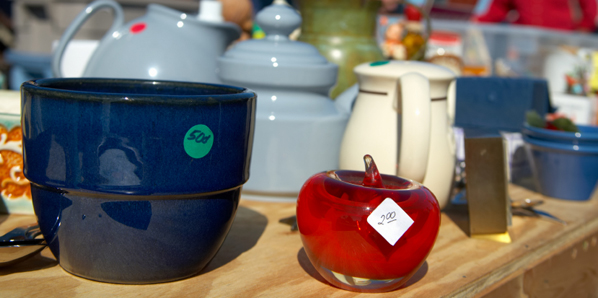Top Six Tips for a Successful Downsizing Sale
It's that time of year again—garage sales are sprouting up on every corner! If you're considering having one or looking for other ways to make money on your discarded treasures here are six tips for success:
Downsizing Tip #1: De-clutter, do it once and save money
De-cluttering to make the house look best for showing is advice often given by real estate agents, but it may lead to a lot of extra work, complication and expense that can be avoided. Making the house look its best for showing is an important consideration, but often what's overlooked is the fact that the option to de-clutter (throw-away, give-away, bulk-sale at a significant discount, or sending off to auction at the cost of packing and moving) needs to be repeated again when you move out.
Handling items multiple times increases your costs and reduces the cash you might recover from selling your goods.
Solution: Clear out just the pure garbage, donation or recycling items. Instead of moving out useful items that could be sold, pack them up and place them out of the way in closets or a side room in a tidy fashion. Later when the house is sold, you can pull out those items for sale along with the other items you are not going to be taking with you. In this case, the house looks tidy, it's less work and leaves more money in your pocket!
Downsizing Tip #2: Avoid making the closing date and the moving date the same
Closing and moving on the same day can create a lot of unnecessary stress and complication as you sort out what to take, what to sell and what to throw away while coming up against a hard deadline.
Often sellers think they need to live in their home right until closing day. Remaining in your home throughout the process can create extra stress, management, and complications. Many downsizing seniors have the flexibility to plan their move in advance of the closing. This offers a number of advantages.
Solution: Plan to move a few weeks before the sale of your house closes. This way you can move out the items you want to keep, but have some flexibility in case you forgot something or something doesn't fit. With what you're keeping out of the house, what's left can more easily be sold.
Downsizing Tip #3: Don't put useful items that have little value in a dumpster
Many tend to see a lot of used goods as simply waste, but it is a shame to see useful goods going into a landfill.
It's sometimes hard to see who would want a worn or tired item, so many sellers assume their only option is to throw it away. For items that are still useable, can be repaired or used for parts, there is often a buyer. You can be environmentally friendly and make money at the same time by finding a way to sell those items.
Solution: Use the power of the Internet to expose your unwanted items to a much wider audience than traditional alternatives.
Downsizing Tip #4: Put the power of competitive bidding to work on your higher value items too
Sellers often guess at the value of their goods and may take the first offer that comes close to their expectation. This may mean missing out on other buyers who are willing to pay much more. On the other hand, if no offers come close to the sellers expectation, the item may be left unsold.
This is particularly important for higher value goods where the value may be difficult to determine and potential buyers may be difficult to find. Instinctively we know that a one-on-one negotiation may not bring the best deal and we want to hear what others are willing to offer. Without competitive bidding from a number of interested potential buyers, it is difficult to know if you will be getting a reasonable return for your more valuable items.
Downsizing Tip #5: Once you decide to sell an item, don't set a reserve or minimum price
An old saying goes: Your item is worth whatever you say it's worth as long as it's not for sale. When you want to sell it, it only matters what someone will pay.
It's a trap to think that having a reserve ensures that you get the price you want for an item. In fact, what it often means is that you don't sell the item just when you need the house empty for closing. This is fine for those who truly want to keep the item, but in the context of downsizing this approach can add effort and stress that you don't need. It also means making tougher choices about how to sell or otherwise dispose of valuable goods or, potentially, paying years of storage fees.
Solution: Use competitive bidding to get the best price you can and encourage lots of bidders to start bidding with no reserve prices. Once engaged, let the excitement of the auction process encourage them to bid prices up to what they are willing to pay. Auction leverages the natural competitive forces of the marketplace to drive prices to their highest level within a given time frame.
Downsizing Tip #6: Choose a low stress approach to selling your unwanted items
Selling the unwanted contents of your house can be challenging and time consuming, but it doesn't have to be that way. You are busy enough with the move and don't need more stress at this point in your life.
Listing items for sale in the classified section of newspapers or online with eBay, Craigslist or Kijiji, can result in a lot of phone calls and emails. These inquiries (e.g., whether the item is still for sale, its features and condition, a time it can be seen and negotiations about the price) can be quite a burden. Allowing strangers to come into your home to inspect can also be a security concern. This approach may not be suitable or desirable for people with lots of items to sell.
Tag sales (also known as content sales) are like a super sized garage sale. A price is tagged to each item and the public is invited to come in on a particular day to buy. It can be a chaotic environment that is difficult to control if a lot of people show up. The owner may be concerned about damage to the home and potential theft of items. A thorough paper trail of what each item sold for may be lacking. At the end of it all, 30% or more of the contents may be left unsold. All this can add unnecessary stress to your move.
Bulk buyers may come in and give you one price to take it all away. They make their money on reselling the higher value goods and will assign little (sometimes negative) value to much of your contents. You may end up with pennies on the dollar and concerns about how many of your items will end up in the landfill. For many people this approach is not an option.
****
Related articles:
Retirement condos: What you need to know about fees
What are the real costs of aging at home?
Retiring in a rural area or small town: What you need to know
Are you a garage sales veteran? Share your best tips in the comments section below!


